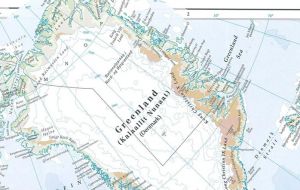MercoPress. South Atlantic News Agency
Times Atlas triggers controversy on the rate of Greenland’s ice loss
 The atlas, published by HarperCollins, showed that Greenland lost 15% of its ice cover over the past 12 years,
The atlas, published by HarperCollins, showed that Greenland lost 15% of its ice cover over the past 12 years, The Times Atlas of the World exaggerated the rate of Greenland's ice loss in its thirteenth edition last week, scientists said on Monday.
The atlas, published by HarperCollins, showed that Greenland lost 15% of its ice cover over the past 12 years, based on information from the National Snow and Ice Data Centre in Colorado in the United States.
The Greenland ice sheet is the second biggest in the world and significant shrinking could lead to a global rise in sea levels.
“While global warming has played a role in this reduction, it is also as a result of the much more accurate data and in-depth research that are now available,” HarperCollins said on its website on Monday.
However, a number of scientists disputed the claim.
”We believe that the figure of a 15% decrease in permanent ice cover since the publication of the previous atlas 12 years (ago) is both incorrect and misleading,” said Poul Christoffersen, glaciologist at the Scott Polar Research Institute (SPRI) at the University of Cambridge.
“We concluded that a sizable portion of the area mapped as ice-free in the Atlas is clearly still ice-covered”. Other scientists agreed.
“These new maps are ridiculously off base, way exaggerated relative to the reality of rapid change in Greenland,” said Jeffrey S. Kargel, senior research scientist at the University of Arizona.
The Times Atlas suggested the Greenland ice sheet has lost 300,000 square kilometres in the past 12 years, at a rate of 1.5% per year.
However, measurements suggest this rate is at least 10 times faster than in reality, added J. Graham Cogley, Professor of Geography at Trent University, Ontario, Canada.
“It could easily be 20 times too fast and might well be 50 times too fast,” he added.
Last year, a UN committee of climate scientists came under fire for bungling a forecast of when Himalayan glaciers would thaw.
The panel's 2007 report, the main guide for governments in fighting climate change, included an incorrect projection that all Himalayan glaciers could vanish by 2035, hundreds of years earlier than scientists' projections.




Top Comments
Disclaimer & comment rules-

Read all commentsRe-draw the map to show climate change? Greenland ice mass maps causing political uproar . Greenland is losing some ice mass due to melting. The Times Atlas, however, is at the middle of a debate after publishing a map that revealed a 15 percent decrease in icemass. Environmental change due to global warming brings big changes.
Sep 28th, 2011 - 04:59 am 0Commenting for this story is now closed.
If you have a Facebook account, become a fan and comment on our Facebook Page!